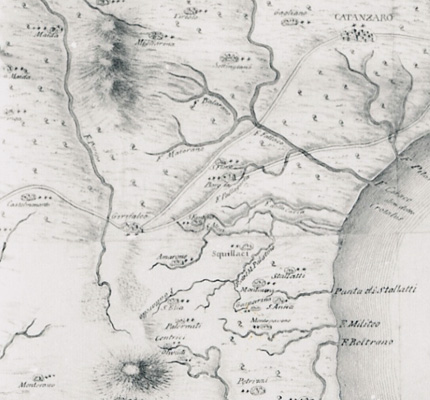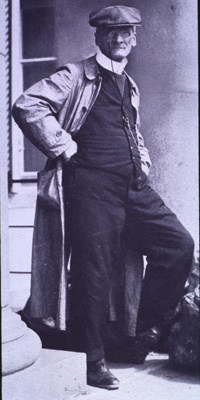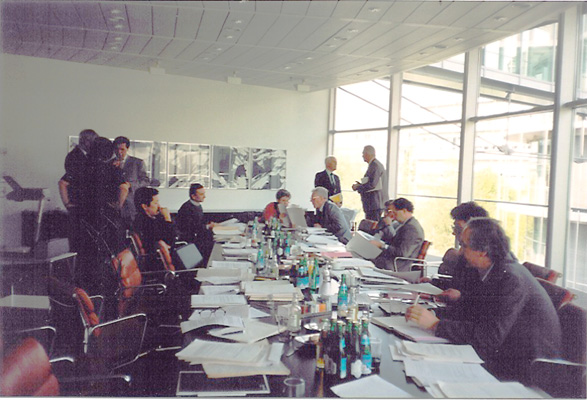The use of intensity scales is historically important because no instrumentation is necessary, and useful measurements of an earthquake can be made by an unequipped observer. The development of intensity as a tool thus predates instrumental seismology (although really not by very much). The earliest recognisable use of intensity as we know it today was by Egen in dealing with a Belgian earthquake in 1828, although simple quantifications of damage had been made in the previous century by Schiantarelli in Italy in 1783 after the Calabrian earthquake of that year.

Detail of Schiantarelli's map of the the 1783 Calabrian earthquake - different symbols are used for villages according to the amount of damage
However, Egen's innovation didn't really catch on at first. It was only in the last quarter of the 19th century that the use of intensity became widespread. Credit for this goes jointly to an Italian, Rossi, and a Swiss, Forel, who published quite similar intensity scales independently in 1874 and 1881 respectively.
The two of them then combined their efforts and produced a joint scale, the Rossi-Forel Scale, with ten degrees of intensity. This was the first scale to be widely used internationally.
The scale was improved by Mercalli, who published a modified version, still with ten degrees. (He had also published an earlier scale of six degrees which was a modification of Rossi's first scale). It appeared, though, that ten degrees were insufficient for expressing the whole range of effects from the weakest to the calamitous. The extension of the scale to twelve degrees was therefore proposed by Cancani. However, Cancani omitted to flesh out his twelve degrees with full descriptions, and restricted himself to titles for each degree (like "destructive") and estimated ground acceleration values.

Giuseppe Mercalli, whose name is so often associated with intensity scales, not always correctly!
It therefore fell to A Sieberg to construct a twelve degree intensity scale with full descriptions of each degree; the first version was published by him in 1912 and subsequently revised twice. Sieberg's scale became the foundation of all modern twelve-degree scales (ie the majority of scales in use today). A version of this scale with slight modifications was published as the Mercalli-Cancani-Sieberg Scale, or MCS Scale, still in use in Southern Europe today. In 1931 it was translated into English by Wood and Neumann who, for some reason, ignored Cancani and Sieberg, and published it under the name of the Modified Mercalli Scale (MM Scale).
This was completely overhauled in 1956 by CF Richter, who refrained from adding his name to the new version in case of further confusion with "Richter Scale" magnitudes. Richter's version became instead the "Modified Mercalli Scale of 1956" despite the fact that the link to Mercalli was now extremely remote. Local modifications of Richter's MM56 scale have been used in Australia, New Zealand and Papua New Guinea. More recent attempts to modernise the MM scale further, eg that of Brazee in 1978, have not caught on. Last time I counted, twelve different versions of the scale existed, all calling themselves "Modified Mercalli", none remotely resembling Mercalli's actual scales. One sometimes sees MM intensities referred to as "Mercalli intensities", which is even more inaccurate.
In 1964 the first version of the MSK Scale was published by Medvedev, Sponheuer and Karnik. This new scale was based on MCS, MM56 and previous work by Medvedev in Russia, and added a new quantitative aspect to make the scale more powerful. This scale became widely used in Europe, and received minor modifications in the mid 1970s and in 1981.
In 1988 the European Seismological Commission agreed to initiate a radical revision of the MSK Scale. A Working Group "Macroseismic Scales" was established under the chairmanship of G Grunthal. At the first meeting in 1990 in Zurich, the framework of the new scale was agreed. The bulk of the text was composed at the second meeting at Munich in 1991. The third meeting, at Walferdange (Luxembourg) in 1992 dealt with the accompanying material (guide to the use, annexes, illustrations, etc). It was decided at Walferdange to drop the name MSK in favour of "European Macroseismic Scale" (EMS).

How intensity scales are made: seismologists debate the formulation of the EMS at Munich in 1991
The material was finalised at a meeting of key members of the WG in Potsdam later in 1992. The scale was published in draft form by the Council of Europe in 1993, and was ratified at the ESC meeting in Reykjavik in September 1996, following a three-year testing period. As a result of experiences gained during testing, further modifications were made, experimental parts were confirmed, and the presentation of the scale was improved. The final version was published in 1998, and is available here. Since its 1993 publication the new scale has been widely adopted outside Europe as well.
The EMS is the first intensity scale that actually comes with instructions for use. Previous scales assumed that the reader would always correctly understand the author's intentions, which experience has shown is not always the case. It is also the first scale with graphic illustrations, ie pictures demonstrating what is meant by the different grades of damage to buildings.
The one important intensity scale that does not have twelve degrees (now that the Rossi-Forel Scale is no longer much in use) is the seven-degree Japanese Meteorological Agency Scale (JMA Scale). This is based on the work of Omori, and is the scale generally used in Japan (but nowhere else).
Roger Musson